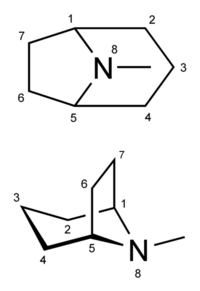Substituted tropanes: Difference between revisions
>Kaylee No edit summary |
>Oskykins |
||
| Line 4: | Line 4: | ||
==Chemistry== | ==Chemistry== | ||
Tropane alkaloids are molecules which contain a substituted tropane ring in their structure. Tropane is a nitrogen-containing bicyclic organic molecule | Tropane alkaloids are molecules which contain a substituted tropane ring in their structure. Tropane is a nitrogen-containing bicyclic organic molecule which consists of a piperidine and pyrrolidine ring fused at carbons R<sub>1</sub> and R<sub>5</sub> along with an additional methyl substitution at R<sub>N</sub>. Tropane alkaloids are commonly substituted at R<sub>3</sub> with an ether bridge (as seen in [[scopolamine]], [[atropine]], [[hyoscyamine]], and [[cocaine]]). | ||
==Pharmacology== | ==Pharmacology== | ||
Revision as of 07:13, 13 November 2016

 |
This article is a stub. As such, it may contain incomplete or wrong information. You can help by expanding it. |
Tropane alkaloids are a class of chemicals that include compounds with psychoactive effects.
Chemistry
Tropane alkaloids are molecules which contain a substituted tropane ring in their structure. Tropane is a nitrogen-containing bicyclic organic molecule which consists of a piperidine and pyrrolidine ring fused at carbons R1 and R5 along with an additional methyl substitution at RN. Tropane alkaloids are commonly substituted at R3 with an ether bridge (as seen in scopolamine, atropine, hyoscyamine, and cocaine).
Pharmacology
 |
This pharmacology section is incomplete. You can help by adding to it. |
Tropane alkaloids are mostly anti-cholinergics (antagonistic action on acetylcholine receptors) or stimulants (prevention of dopamine reuptake).
Examples
Tropane alkaloids are seen throughout organic chemistry and include psychoactive and anaesthetic compounds.
Anticholinergic drugs:
Stimulant drugs:
See also
References
 |
This article does not cite enough references. You can help by adding some. |